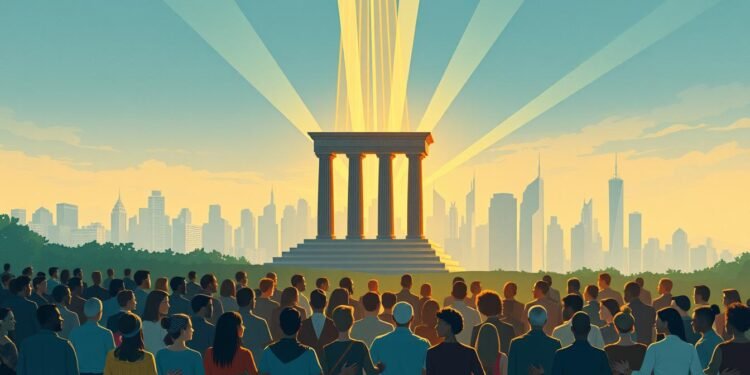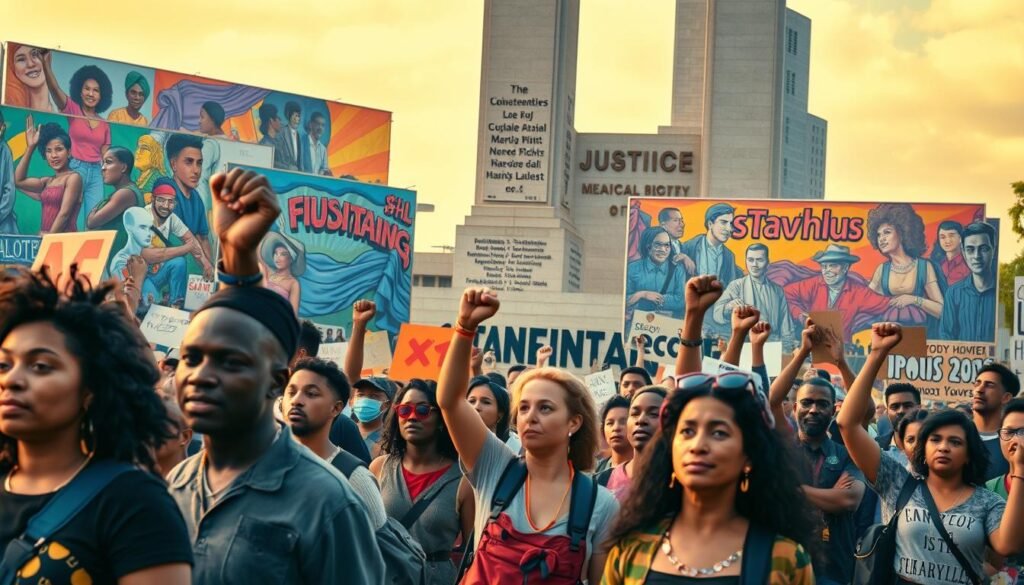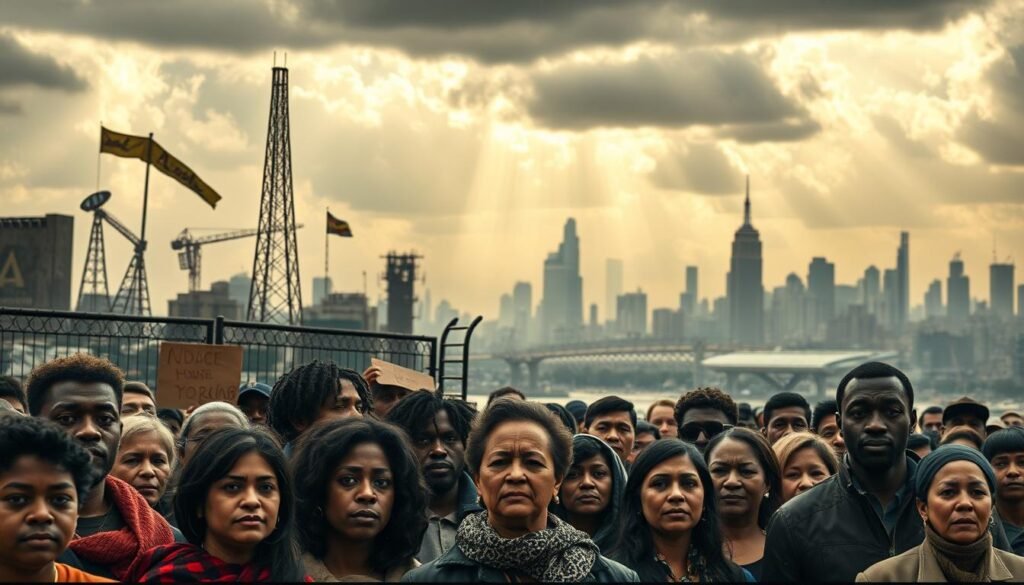What if the world we live in could truly offer equal chances for everyone, regardless of background or identity?
This question lies at the heart of social justice. It is about fairness in how wealth, opportunities, and privileges are shared in society.
Social justice ensures that individual rights are protected. It focuses on breaking down barriers that limit people’s mobility and access.
Key institutions like education, healthcare, and labor laws play a big role. They help distribute resources and create safety nets for those in need.
Throughout history, the pursuit of a just society has evolved. From ancient ideas to modern movements, the goal remains creating equity for all.
Key Takeaways
- Social justice promotes fair distribution of wealth, opportunities, and privileges in society.
- It emphasizes protecting individual rights and breaking down systemic barriers.
- Institutions like education and healthcare are crucial for achieving equitable outcomes.
- Historical movements have shaped modern understanding and applications of justice.
- Key principles include access, participation, and respect for human rights.
- Challenges include political opposition and the need for broader societal engagement.
- Continuous effort across communities is essential for meaningful progress.
Understanding Social Justice: A Foundational Overview
Social justice means every person and group gets fair treatment and equal status. It covers social, political, and economic areas. This idea focuses on making sure all people have the same chances.
Laws, policies, and institutions help put this into practice. They work to give fairness, especially to those who are often left out. This includes making sure benefits and burdens are shared fairly.
Another key part is contributive justice. This values meaningful work and taking part in community life. It helps people feel dignity and fairness in their daily lives.
Equal opportunities let everyone help and gain from the common good. This can mean having a say in public matters or holding office. It supports self-growth and stops oppression.
Martha Nussbaum’s capability approach is important here. It says justice should help people do things that make life fully human. This ties into human rights like civil, political, and economic rights.
Social justice is both a theory and a goal for action. It changes with time and culture but always aims to make things better. It builds on old ideas to fix today’s problems.
This concept is rooted in the broader idea of justice itself. It uses past thinking to address current issues and push for reform.
The Historical Roots of Social Justice
Long before modern movements, ancient thinkers laid the groundwork for fairness in society. Their ideas about proper community organization still influence today’s concepts of equitable treatment.
These early philosophies explored how to create harmonious societies where each member contributes meaningfully. They addressed fundamental questions about distribution of resources and opportunities.
Ancient Philosophical Foundations: Plato and Aristotle
Plato’s Republic presented a vision where individuals found roles matching their natural abilities. He saw justice as the binding force that creates societal harmony and strength.
Aristotle developed concepts of distributive justice based on merit and common good. His approach emphasized fair distribution according to contribution and virtue.
Socrates introduced early social contract theory in Crito. He suggested people follow societal rules in exchange for protection and benefits.
Medieval and Enlightenment Evolution: Aquinas to Paine
Thomas Aquinas connected justice with divine service and promoting common good. His medieval perspective supported social hierarchy while emphasizing ethical duties.
Enlightenment thinkers like Thomas Paine advocated for equal opportunities for all capacities. He believed society should provide “genius a fair and universal chance.”
The term “social justice” itself emerged in the 1840s through Jesuit priest Luigi Taparelli. He rooted this concept in Thomistic metaphysics as response to economic theories.
Taparelli argued that social justice reflects our duty to others in interdependent communities. He emphasized ethics over purely economic considerations.
John Stuart Mill’s utilitarian perspective called for society to treat all equally well who deserve it. This became a standard for social and distributive justice concepts.
These historical foundations, while often supporting hierarchies of their time, created groundwork for modern equity movements. They established principles that would evolve toward greater inclusion.
The Birth of Modern Social Justice
Industrial era inequalities created the perfect conditions for social justice to evolve from theory to practice. This transformation occurred through specific thinkers and movements that gave the concept concrete meaning.
Coining the Term: Luigi Taparelli and 19th-Century Thought
The phrase first appeared in late 1700s writings with unclear meanings. Critics often dismissed it as mere rhetorical flourish without practical application.
Jesuit priest Luigi Taparelli changed this in the 1840s. He established social justice as a natural law principle rooted in brotherly love.
Taparelli saw society as an interdependent community. His work emphasized unity and ethical duties toward others.
After the 1848 revolutions, Antonio Rosmini-Serbati’s writings expanded the term’s reach. This helped move the concept beyond academic circles.
20th Century Integration: From Legal Reform to International Law
Progressive Era American scholars adopted the term to address economic problems. Louis Brandeis and Roscoe Pound used it to fight labor issues and wealth gaps.
The Industrial Revolution’s harsh conditions made these reforms urgent. Workers faced poor treatment and limited rights.
International recognition came in 1919. The International Labour Organization’s preamble declared that peace must be based on social justice.
John Rawls’ 1971 work, A Theory of Justice, became extremely influential. He placed fairness at the center of social contract philosophy.
The Vienna Declaration of 1993 globalized the concept further. It made social justice a key purpose of human rights education worldwide.
This evolution turned theoretical ideas into practical goals. Modern approaches now address contemporary issues through institutional changes.
Key Philosophical Theories of Justice
The quest for a fair society finds expression through various philosophical lenses that guide policy and practice. These frameworks offer different approaches to understanding what constitutes a just distribution of resources and opportunities.
John Rawls and Justice as Fairness
John Rawls developed a influential theory called justice as fairness. He argued each person has fundamental rights that cannot be violated.
Rawls proposed two key principles for a just society. First, everyone should have equal basic liberties. Second, social and economic inequalities must benefit the least advantaged members.
He introduced the “veil of ignorance” thought experiment. Imagine choosing society’s rules without knowing your own position. This ensures principles are fair to all.
Thomas Pogge and Institutional Responsibility
Thomas Pogge focuses on how institutions affect human rights. He argues they should not harm poor populations around the world.
Pogge believes global institutions bear responsibility for poverty. They must be accountable for policies that create deprivation.
His work highlights issues like corporate tax evasion. These practices can worsen economic disparities between nations.
Contributive Justice and the Role of Dignity
Andrew Sayer developed the concept of contributive justice. This approach values meaningful work and community participation.
It emphasizes human dignity through active contribution. People find purpose when they can meaningfully participate in society.
This theory goes beyond simple distribution of wealth. It focuses on the quality of work and engagement opportunities.
These philosophical theories continue to shape contemporary discussions. They inform approaches to equity, rights, and institutional design across communities.
Each offers unique insights into creating fairer societies. They provide frameworks for addressing systemic inequality and promoting human dignity.
The Role of Institutions in Promoting Social Justice
Global organizations play a vital part in advancing fairness worldwide. They create frameworks that guide nations toward equitable policies.
These bodies help translate principles into actionable strategies. Their work ensures consistent progress across different regions.
The United Nations and Global Social Justice
The United Nations defines this concept as essential for peaceful coexistence. It emphasizes fair distribution of economic growth benefits.
Their 2006 document, “Social Justice in an Open World,” calls for strong redistributive policies. This approach helps prevent violence and chaos in societies.
The UN integrates these ideals into human rights frameworks. Key instruments include the Universal Declaration of Human Rights.
Historical context shows early adoption in Soviet-influenced texts. The 1969 Declaration on Social Progress and Development marked important steps.
Special focus areas include children’s rights and vulnerable populations. Targeted efforts address specific needs within communities.
Neglect of these principles can lead to repression according to UN analysis. International cooperation remains crucial for implementation.
The International Labour Organization connected peace to just labor conditions early on. This established important foundations in international law.
Various UN programs address inequalities through equitable development. They work across countries to promote sustainable progress.
Global organizations support and amplify local initiatives effectively. This creates powerful networks for change worldwide.
The UN positions compassionate economic distribution as a cornerstone. This vision supports long-term global stability and prosperity.
The Four Essential Pillars of Social Justice
Creating lasting fairness in communities depends on four fundamental building blocks. These interconnected components form the structural foundation for meaningful societal transformation.
Each pillar supports the others in creating comprehensive systems of fairness. Together, they address different dimensions of what makes societies truly equitable.
Human Rights: The Bedrock of a Just Society
Basic human dignity forms the cornerstone of any fair system. These fundamental protections ensure every person receives respectful treatment.
International frameworks establish universal standards for humane conditions. They create minimum requirements that all communities should meet.
This concept and human rights often work interchangeably. Each reinforces the other in protecting individual worth and opportunity.
Access: Ensuring Essential Goods and Opportunities
Vital resources must reach everyone without artificial barriers. Shelter, nutrition, medical care, and learning form the basics of dignified existence.
When systems limit these essentials based on background, entire groups suffer. Such restrictions harm both individuals and broader community development.
Affordable healthcare policies demonstrate this principle in action. They remove financial obstacles that prevent people from receiving necessary treatment.
Participation: Amplifying All Voices
Meaningful inclusion requires hearing from every community member. Those traditionally excluded must help shape decisions affecting their lives.
Marginalized groups offer unique perspectives on solving shared problems. Their input leads to more effective and representative solutions.
Inclusive governance structures put this principle into practice. They ensure diverse voices contribute to policy creation and implementation.
Equity: Achieving Fair and Just Outcomes
This approach recognizes that different circumstances require varied support. Unlike simple equality, it accounts for historical disadvantages and current barriers.
Imagine a baseball game where shorter players need boxes to see over the fence. Equity provides tailored assistance to create genuinely equal experiences.
Targeted programs for disadvantaged communities demonstrate this principle. They address specific needs rather than applying identical solutions to unequal situations.
These four pillars operate as an interconnected system. Without guaranteed access and full participation, basic rights and fair outcomes remain elusive.
Movements advocating for LGBTQ+ protections use all these components. They fight for rights, access, voice, and equitable treatment simultaneously.
Global standards like UN policies emphasize this comprehensive approach. They recognize that lasting change requires addressing multiple dimensions of fairness.
A holistic strategy creates more sustainable progress toward genuinely equitable societies. It ensures all aspects of human dignity receive proper attention and support.
Examining Key Social Justice Issues
Across our communities, certain groups face persistent barriers to fair treatment. These challenges require focused attention and thoughtful solutions.
Understanding these complex issues helps us work toward meaningful change. Each area involves unique historical contexts and current realities.
Racial Inequality and Systemic Discrimination
Historical systems continue affecting opportunities today. Slavery and Jim Crow laws created lasting disadvantages.
These structures impact access to quality education and healthcare. Employment opportunities also remain unequal across racial lines.
Race is a social construct rather than biological reality. Solutions must address systemic barriers rather than false biological claims.
Many communities experience compounded disadvantages. Poverty often intersects with racial discrimination.
Gender Inequality and the Fight for Women’s Rights
Global gender equality may take 135 years to achieve. Persistent pay gaps and educational disparities slow progress.
Reproductive rights restrictions limit women’s autonomy. These policies affect health outcomes and economic opportunities.
The Covid-19 pandemic worsened existing inequalities. Women faced increased caregiving duties and job losses.
Workplace policies often fail to support working mothers. Flexible arrangements and equal pay remain elusive goals.
LGBTQ+ Rights and the Pursuit of Inclusion
Violence and discrimination threaten safety for many individuals. Trans and non-binary people face particularly high risks.
Legislative challenges have increased significantly. Over 240 anti-LGBTQ+ bills were filed in the U.S. by March 2022.
These measures limit access to healthcare and public spaces. They also restrict educational content and youth participation.
Inclusive policies protect vulnerable community members. Advocacy efforts continue fighting for comprehensive protections.
These justice issues demonstrate the need for continued action. Movements and policies must address intersectional disadvantages.
Comprehensive approaches create more equitable societies for all people. They ensure better access to resources and opportunities.
Social Justice Movements Throughout History
Throughout modern history, organized efforts have pushed societies toward greater fairness. These collective actions transformed abstract principles into concrete improvements for everyday life.
Each movement built upon previous struggles while addressing new challenges. They created lasting changes in laws, attitudes, and opportunities.
Labor Rights and the Industrial Revolution
The Industrial Revolution brought harsh conditions for many workers. Long hours and low pay became common in factories.
Labor movements fought for basic protections and fair treatment. They organized strikes and advocated for policy changes.
These efforts led to the eight-hour workday and safer workplaces. Unionization gave workers collective bargaining power.
Philosophical ideas about fairness supported these practical struggles. They provided intellectual foundations for demanding better conditions.
The Civil Rights Movement and Racial Equality
The 1950s and 1960s saw powerful activism against racial discrimination. African Americans faced segregation and voting restrictions.
Nonviolent protests and legal challenges created significant change. Landmark legislation included the Civil Rights Act and Voting Rights Act.
Key figures like Martin Luther King Jr. inspired nationwide support. Their work addressed systemic barriers to equal participation.
This movement demonstrated how organized action could transform society. It became a model for other groups seeking fairness.
Modern Movements: Feminism and LGBTQ+ Advocacy
Contemporary efforts continue the push for inclusive communities. Feminism addresses gender inequality in pay and representation.
Reproductive rights and workplace policies remain important issues. These affect women’s health and economic opportunities.
LGBTQ+ advocacy fights discrimination and promotes inclusion. It seeks equal treatment under law and in daily life.
Modern approaches often address multiple forms of inequality simultaneously. They recognize how different disadvantages can overlap.
Global organizations like the United Nations support these efforts worldwide. They help establish standards that protect human dignity.
These historical movements show the ongoing work toward equitable societies. They continue inspiring new generations to push for positive change.
Contemporary Challenges and Critiques
Even with progress, many obstacles still block the path toward fair treatment for all. These modern problems test our commitment to creating a better world.
Addressing Systemic Barriers and Economic Disparities
Global wealth gaps continue to grow despite economic development. Corporate tax evasion and illegal money flows hurt poorer nations.
These practices keep poverty alive in many communities. They prevent fair distribution of resources and opportunities.
Climate change creates new justice issues for vulnerable groups. Extreme weather events hit disadvantaged areas hardest.
Technology brings both promise and problems. Digital divides limit access to education and employment for some people.
The United Nations works to address these institutional designs. They promote policies that help rather than harm developing countries.
Navigating Political Opposition and Philosophical Debates
Some thinkers question the very concept of social justice. Friedrich Hayek called the term meaningless and vague.
Libertarians often oppose wealth redistribution. They argue it violates individual rights and freedoms.
Philosophical debates continue about global responsibility. Thomas Pogge’s ideas face both support and criticism.
Communitarians challenge Rawls’ theory for ignoring community values. They believe it focuses too much on individual rights.
Modern movements sometimes face accusations of going too far. Critics claim they create division rather than unity.
Advocates respond with evidence-based policies and dialogue. They stress inclusive participation for all group members.
Historical struggles inform today’s approaches to these challenges. Past lessons help shape current solutions for equity.
International cooperation remains crucial for meaningful change. Together, countries can build a more just society for every person.
Conclusion: The Enduring Pursuit of a More Just Society
The journey toward fairness is a continuous effort that spans centuries. It calls for respect for human rights and equal access for all.
Key principles like participation and equity help build stronger communities. They ensure every person can thrive and contribute meaningfully.
Historical movements and modern reforms show that progress is possible. Despite challenges, commitment to these ideals drives real change.
Global cooperation and strong institutions play a vital role. Together, we can create a world where everyone enjoys dignity and opportunity.
FAQ
What is the main goal of advancing social justice?
The primary aim is to create a society where all individuals have equal rights, opportunities, and access to resources, regardless of their background or identity.
How did ancient philosophers like Plato and Aristotle contribute to social justice concepts?
Plato explored ideas of fairness in “The Republic,” while Aristotle discussed distributive justice, laying early groundwork for ethical treatment in communities.
When did the term "social justice" first emerge?
The phrase was coined in the 19th century by Italian scholar Luigi Taparelli, who integrated it into discussions about moral order and societal structures.
What are the four pillars essential to social justice?
They include human rights as a foundation, access to necessities, participation in decision-making, and equity to ensure fair outcomes for everyone.
How do institutions like the United Nations promote global social justice?
The UN advocates through declarations, policies, and programs that emphasize human dignity, economic development, and protection against discrimination worldwide.
What role did the Industrial Revolution play in social justice movements?
It highlighted worker exploitation, leading to organized labor rights campaigns that fought for better wages, safer conditions, and fair treatment.
What are some common contemporary challenges in achieving social justice?
Current obstacles include systemic barriers, economic inequality, political opposition, and ongoing debates over how to implement equitable solutions effectively.







